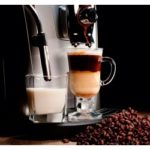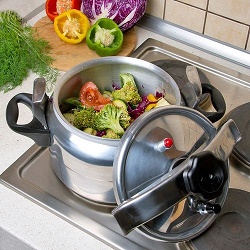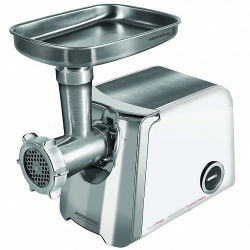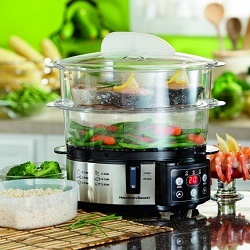Varieties of modern coffee machines
In the existing variety of home appliances it is easy to get lost. Coffee machines include many specific modifications, divided into subspecies and varieties. Anyone who has ever encountered the choice of this device, necessary for every coffee lover, will confirm that it is sometimes very difficult to understand. Existing types of coffee machines work on a different principle, they have a very different technology for preparing a drink, and the final product turns out to be of different strength and consistency. So, let's see what are the coffee machines, and denote their main features.
Today the most common types can be distinguished: plunger coffee makers, espresso, geyser and drip type devices.
Content
Plunger coffee maker (French press)
Invented long ago, in the twenties of the last century in Europe. The device quickly gained fame and in a short time spread throughout the old world, thanks to its simplicity, reliability and high quality of the final product.
The principle of operation of this type of coffee maker is quite simple. Ground coffee is poured into a device made of tempered, heat resistant glass, and boiling water is poured. At the bottom of the brewing tank is thin filter, which will not allow the coffee grounds to penetrate into the main reservoir for a drink. Brewed coffee is allowed to settle for some time (5-10 minutes, depending on the type of grain), and then the remnants are squeezed out with the help of a metal piston. As it is easy to notice, no additional maintenance is required: pour the grain, pour boiling water and rinse the coffee pot after use.
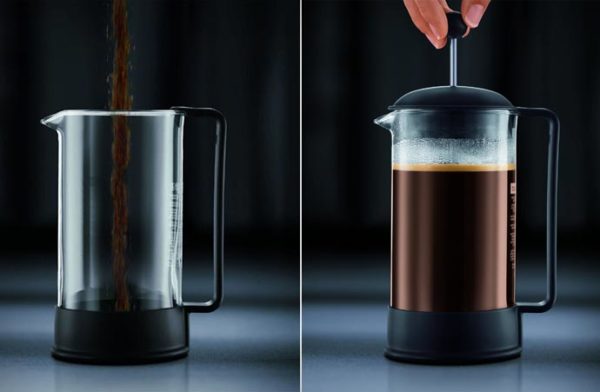
Pros:
- Affordable price, does not require connection to the mains.
- The metal rod creates a lot of effort, and, together with the filter, it lets in more sediment and heavy oils than the drip coffee makers, for example, cannot boast.
- Dimensions of devices: this is just a small kettle, made of glass, so you can easily take it with you on the road, a trip or to the country.
Minuses:
- No automatism, only manual mode is applicable here.
- In addition to the above, for making coffee you need boiling water, and, consequently, a kettle. An inconvenience this can only be called a stretch, since, most likely, the kettle can be easily found in any kitchen. Such a limitation in functionality drastically reduces the level of usability.
The process of preparing a drink in a french press should not be entrusted to children, as this can be traumatic. However, this rule most often applies to other types of coffee machines.
An important feature: if the coffee maker is served on the table along with the dishes, then to achieve aesthetic unity, it is necessary that both the cups and the appliance look similar. In addition, do not forget to wash the coffee maker as often as possible, because the oils contained in the grains, very quickly destroyed. Grind the grain should be right before cooking. For lovers of pronounced flavor best coarse grinding.
Filter type coffee machine (drip)
This type of coffee machines is very popular both here and in other countries. This type of coffee maker was invented in the 18th century, in Paris. As it is easy to guess from the name, the principle of making coffee is directly related with filtering. The device is divided into two tanks: for cold water and for the finished drink. Water passes through the heating circuit, turning into steam, then, after condensation, water with a temperature of 86 ° to 97 ° C enters the coffee filter and slowly passes through it, absorbing all the taste and aromatic qualities of the grains. The finished drink flows into a specially heated tank.
Some technologically advanced models of coffee machines have a drop-stop function. Such devices have a more complex technical basis and device, so you should be more careful in the process of operation.
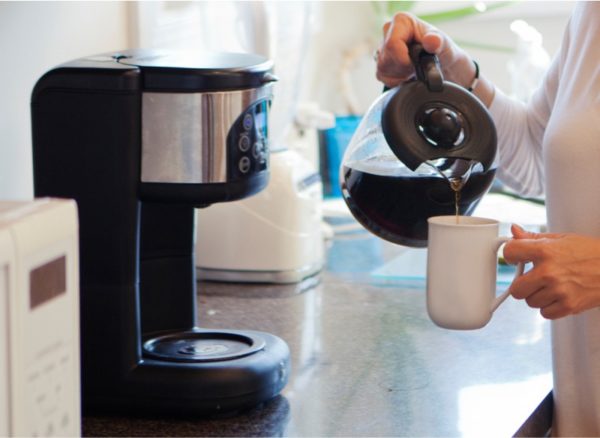
Drip coffee makers have different types of filters:
- Nylon (ordinary reusable filter, medium degree of filtration, approximately 50 brews).
- Nylon with a “gold” coating (it lasts longer, it is easier to wash, but it costs more).
- Disposable paper filter. In some devices of a high price segment include filters from harmful impurities (scale, chlorine, nitrate).
The capacity of the apparatus itself can be made of plastic, glass or a special thermal material that holds heat for a long time. The narrow neck helps to preserve the aroma, if you plan to transport the drink.
Other technological advantages (cable compartment, heated stainless steel tank, etc.) will vary. from the priceand here the buyer is free to choose which functions he needs and which ones he can do without.
Pros:
- Very convenient to use.
- At one time you can prepare a large portion of the invigorating drink of one fortress.
- Heated flasks will keep coffee hot for a long time.
- This type of coffee machines has an affordable price.
- Dimensions convenient for transportation.
Disadvantages:
- Because of the design features, the brewed coffee quickly loses its flavor.
- In the drip coffee machine it is impossible to make coffee with foam.
- In addition to the grains have to buy more filters.
- You can only make black coffee, without adding milk or cream (cream).
Coffee maker geyser type
Oddly enough, but this type of coffee machines was also invented in the 19th century, and also in Europe - in Italy. Since then, little has changed in the design of the device, except that the power supply function has been added, which allows several to automate the process. The real name (at least in the home country) is “moka express” or “moka sweat”.
Moka devices are divided into two types: with power supply and without heating function (heated on the stove).
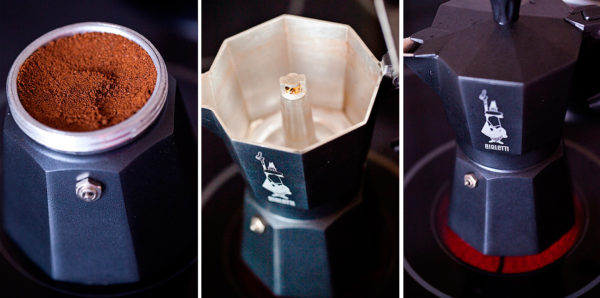
The main metal compartment serves as a water tank, there is also a filter and a small section for the finished coffee. In the geyser coffee makers drink cooking on low heat. As the water is heated, it goes up the cylinder, passes through the ground coffee, and after soaking it, enters the tank for the final product. There is only one significant drawback - with this method of preparation, the flavor of the drink is quite quickly lost. The pressure of the various models comes from 1.5 to 4 bar. The power of the device can be different - from 400 W to 1.2 W, the volume of coffee makers also varies significantly, there is no one standard here.
Of the pleasant bonuses can be noted: heat-resistant handle,transparent container for the finished drink, automatic shutdown, metal filter, the ability to adjust the strength of the drink, the presence of a thermostat and an electronic control panel.
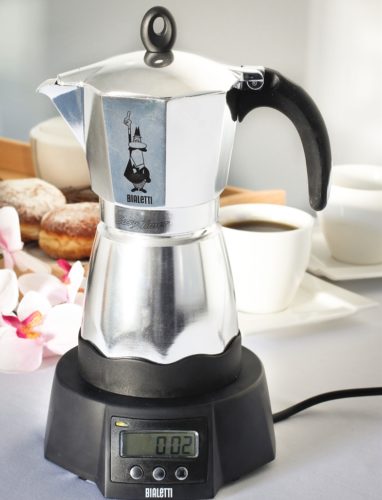
Geysernaya coffee maker with power supply
Pros:
- Easy to use.
- The final product is much better than that of a coffee machine. drip type.
- It is inexpensive.
- Convenient dimensions.
- If desired, this coffee machine can be used outside the house.
- In "Moka Pot" you can make not only coffee, but also medicinal drinks, teas.
Minuses:
- There is no possibility to regulate the size of the portion prepared, if the coffee maker has a size of 3 cups, then it will always be necessary to cook this amount.
- Oxidative processes that, one way or another, occur with aluminum coating, adversely affect the quality of taste.
- There is no way to make coffee with froth.
- The only possible consumable - ground coffee.
Espresso coffee machines (compression type)
The types of coffee makers and automatic coffee machines presented in our review are significantly inferior in technological innovations to the compression type apparatus. This type of coffee makers (they are often called “coffee machines” for a high degree of automation of the process) got its name (espresso) from the Italian es presso (under pressure).The first sample of such a device was presented in the middle of the 19th century. In the future, espresso appliances have become widespread throughout the world.
They allow you to prepare excellent coffee with a rich taste and unsurpassed aroma. This is achieved through a technologically complex process of heating the fluid and increasing the pressure in the system.
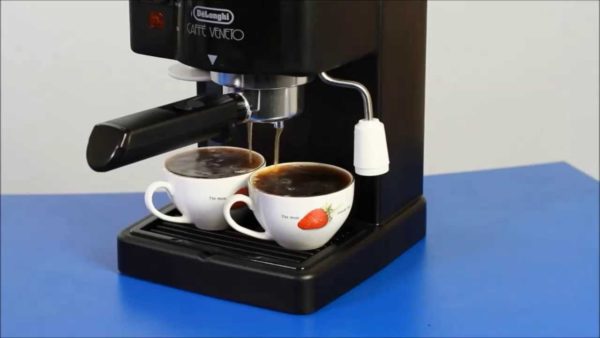
Boiling water or steam heated to the optimum temperature passes under a pressure of 15 bar (sometimes more - 30-32 bar) through the coffee mixture. In the apparatus there is a special compartment for the liquid, but water does not directly participate in the preparation of the drink, it serves for heat exchange processes and beating dairy products. Such coffee machines inside is many sensors, constantly monitoring the temperature, and if required, raising it to 110-120 degrees.
To maintain constant pressure, a one-way valve is integrated. After passing through the mixture, the drink enters the cup, absorbing up to 25% of the properties of ground coffee, and a beautiful froth forms on the surface of the cup.
Due to the automated process, the drink is prepared fairly quickly - approximately 20 seconds.
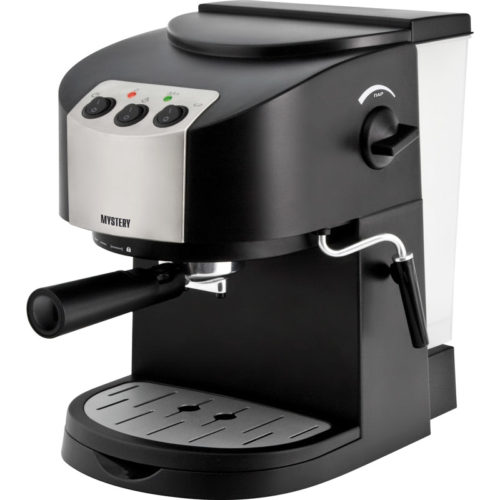
Carob espresso coffee machine
Espresso machines are of 2 types: steam and pump. The latter are more expensive, but they also prepare a more delicious drink. Carob coffee makers are also distinguished (the mixture is placed in a special horn), combined (drip preparation of the drink plus the ability to prepare espresso) and fully automatic devices (many functions and possibilities to make adjustments to the process of preparing the drink).
Different types of coffee are poured into espresso machines:
- grain (there are devices with built-in coffee grinder);
- ground;
- pods (disposable compressed tablet in a paper bag);
- capsules with powder.
Capsular coffee machines are arranged as follows: a loaded capsule with coffee makes its way immediately in several places. Further, the powder contained inside is mixed with boiling water and poured through the “spout”.
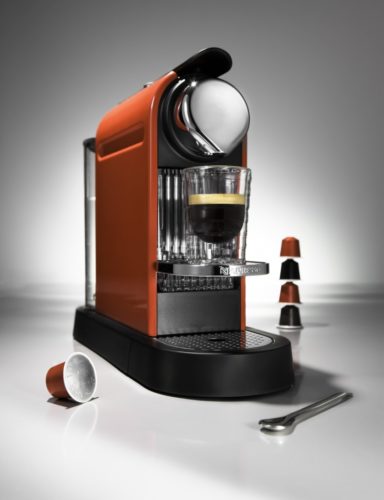
Capsular coffee machine
Feature of capsular coffee machines is that you can choose a drink from a very limited set of flavors. Each manufacturer produces only a few options for coffee drinks.
Advantages of espresso coffee machines:
- Manufacturability and modern look.
- Convenience and comfort in use.
- Quick drink preparation.
- Excellent taste of coffee, the presence of a thick crema.
- Just understand the operation, do not follow the preparation.
Minuses:
- The obvious disadvantage that applies to all types of espresso machines is the high cost of consumables (pods or capsules).
- Expensive machine maintenance.
- The complex technological component over time leads to hangs and failures in the system of the device.
findings
Some types of coffee machines are able to prepare an invigorating drink in a fully automatic mode, without requiring the participation of the owner, but need daily cleaning, others quickly prepare the drink, while paying a minimum of attention, but the cost of consumables drastically reduces the feasibility of using such a device. Another kind of seemingly devoid of these shortcomings, but binds its owner to him, not allowing to move away from the stove until the coffee is cooked, otherwise there is a risk of getting everything around if the boiled drink runs away.
As we can see, no type of coffee machine is not without flaws, so everyone can choose for themselves the machine that matches their needs.

/rating_off.png)






